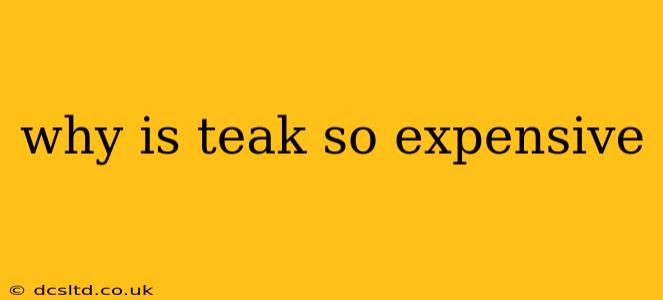Teak (Tectona grandis) commands a premium price in the lumber market, and for good reason. Its high cost is a result of a complex interplay of factors, from its inherent properties to the challenges involved in its sustainable cultivation and harvesting. Let's delve into the key reasons why teak remains a luxury wood.
What Makes Teak Unique? Its Exceptional Properties
Teak's inherent qualities are a major contributor to its high price tag. It's renowned for its:
- Exceptional Durability: Teak is incredibly resistant to rot, decay, and insect infestation. This is partly due to its naturally high oil and silica content, making it ideal for outdoor applications where it can withstand harsh weather conditions for decades.
- Stunning Appearance: The rich golden-brown hue of teak, often streaked with darker tones, is highly sought after. Its beautiful grain pattern adds to its aesthetic appeal, making it a desirable choice for fine furniture and decking.
- Dimensional Stability: Teak is less prone to warping, shrinking, or expanding than many other hardwoods. This stability is crucial for applications requiring precise dimensions and long-term performance, such as boatbuilding and high-end construction.
- Weather Resistance: The high oil content acts as a natural sealant, protecting the wood from the elements. This significantly reduces maintenance needs compared to other woods.
The Challenges of Sustainable Teak Farming and Harvesting
The cost of teak isn't just about its properties; it also reflects the difficulties in sustainable sourcing:
Slow Growth: Teak is a slow-growing tree, requiring many years to reach maturity and harvest-ready dimensions. This long maturation period directly impacts the supply and ultimately the price.
Sustainable Harvesting Practices: Concerns about deforestation have led to stricter regulations and certification programs for teak harvesting. Sustainably sourced teak, which is environmentally responsible, commands a higher price than illegally harvested timber. This is crucial for preserving teak forests for future generations.
Geographic Limitations: Teak thrives in specific tropical and subtropical climates, limiting its cultivation to certain regions. This geographic restriction further influences supply and cost.
Labor Costs: Harvesting and processing teak is labor-intensive, involving skilled workers who understand the proper techniques to maximize yield and minimize waste. These labor costs are factored into the final price.
Processing and Transportation: Preparing teak for use involves multiple steps, including drying, milling, and potentially treating the wood. The cost of transportation from its origin to markets around the world also adds to the expense.
Is the Price of Teak Justified?
The high cost of teak reflects its unique combination of desirable properties and the challenges associated with responsible sourcing. While it's undeniably expensive, its longevity, beauty, and sustainability, when sourced responsibly, often justify the investment for those seeking high-quality, long-lasting wood products.
Frequently Asked Questions (Addressing People Also Ask)
While I couldn't access real-time search engine data for "People Also Ask" questions, here are some frequently asked questions about teak's cost:
How much does teak wood cost per board foot?
The price per board foot of teak varies significantly depending on factors like grade, size, and source. It typically ranges from several dollars to several hundred dollars per board foot, making it considerably more expensive than most other hardwoods.
Is teak worth the price?
Whether teak is "worth the price" is subjective. If longevity, durability, beauty, and sustainability are priorities, then the higher cost might be justified. For those on a tighter budget, alternative hardwoods may be more suitable.
What is the best way to buy teak wood?
The best way to buy teak is from reputable suppliers who can provide documentation proving the wood's sustainable origin. Look for certifications like the Forest Stewardship Council (FSC) to ensure responsible sourcing.
Are there cheaper alternatives to teak?
Yes, several other hardwoods offer comparable durability and weather resistance, although they might not possess teak's unique aesthetic qualities. Some alternatives include ipe, cedar, and mahogany, each with its own price point and characteristics.
By understanding the factors contributing to teak's high cost, consumers can make informed decisions about whether this premium hardwood is the right choice for their needs and budget.
